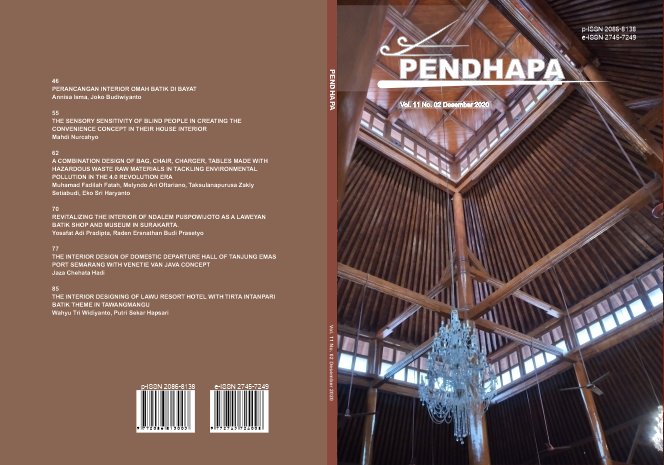The Interior Designing of Lawu Resort Hotel with Tirta Intanpari Batik Theme in Tawangmangu
Main Article Content
Abstract
The increasing number of tourists visiting Tawangmangu tourist attraction, Central Java, and yet insufficient lodging facilities are some of what is behind the interior designing of Lawu Resort Hotel. Lawu Resort Hotel is a lodge with facilities to accommodate tourist activities. The design theme is intanpari tirta batik design with a contemporary style, meanwhile the design goal is to present an interior that follows current times advancement but still concerns on the culture. The design method adopted the stages of the Pamudji Suptandar design process with an outline of the process consisting of input, synthesis and output. The scope of work includes a lobby, restaurant, coffee lounge and guest room. The design results are in the form of a design proposal, which includes design concepts, work drawings, material schemes and animation.
Downloads
Article Details
Authors who publish with Pendhapa agree to the following terms:
- Authors retain copyright and grant the journal right of first publication with the work simultaneously licensed under a Creative Commons Attribution License (CC BY-SA 4.0) that allows others to share the work with an acknowledgment of the work's authorship and initial publication in this journal.
- Authors are able to enter into separate, additional contractual arrangements for the non-exclusive distribution of the journal's published version of the work (e.g., post it to an institutional repository or publish it in a book), with an acknowledgment of its initial publication in this journal.
- Authors are permitted and encouraged to post their work online (e.g., in institutional repositories or on their website) prior to and during the submission process, as it can lead to productive exchanges, as well as earlier and greater citation of published work.

This work is licensed under a Creative Commons Attribution-ShareAlike 4.0 International License.
References
Ali, F., Hussain, K., & Ryu, K. (2016). Resort hotel service performance (RESERVE) – an instrument to measure tourists’ perceived service performance of resort hotels. Journal of Travel & Tourism Marketing, 34(4), 556–569. doi:10.1080/10548408.2016.1208789
Andereas Pandu Setiawan. 2005. “LABORATORIUM BAHAN INTERIOR SEBAGAI PENDUKUNG KEBERHASILAN PROSES PEMBELAJARAN DESAIN INTERIOR.” Dimensi Interior 3 (1).
Anggraini, Denny Astrie. 2020. “Analisis Resiko Kecelakaan Kerja CV.Mitra Kreasi Utama Dengan Menggunakan Metode HAZOP (Hazard and Operability Study).” Jurnal Surya Teknika 6 (1). https://doi.org/10.37859/jst.v6i1.1859.
Hartanti, Sri. 2016. “Sri. Kajian Motif Batik Tirta Intanpari Sebagai Seragam Pegawai Di Kabupaten Karanganyar Dengan Metode Komparatif.” Surakarta.
Hidayanti, Fitria, Kiki Rezki Lestari, and Alvin Liyanto. 2020. “Soundproofing Wall: A Review.” International Journal of Emerging Trends in Engineering Research 8 (9). https://doi.org/10.30534/ijeter/2020/81892020.
Karyono, A Hari. n.d. Kepariwisataan. Grasindo.
Marlina, Endy. 2008. Panduan Perancangan Bangunan Komersial. Yogyakarta: Andi Offset.
Nugraha, Azhari Fauzi Din, Budi Praptono, and Muhammad Iqbal. 2015. “Usulan Perbaikan Kemasan Produk Menggunakan Metode Quality Function Deployment Pada Usaha Tahu Kinanti.” EProceedings of Engineering 2 (2).
Pattiasina, Brian J., Roosje J. Poluan, and Fela Warouw. 2019. “PERANCANGAN APARTMEN DI AMBON. ARSITEKTUR KONTEMPORER.” Jurnal Arsitektur DASENG 8 (2).
Putro, Tunjung Atmadi Suroso, and Kiki Nurmalah. 2019. “Desain Interior Museum Modern and Contemporary Art in Nusantara, Konsep Global Metropolitan Culture.” Jurnal Desain Interior 4 (2). https://doi.org/10.12962/j12345678.v4i2.5709.
Rasyid, Waldi. 2014. “DESAIN BUKU PSIKOLOGI WARNA.” Jurnal UNP 8 (33).
Sumarno, Dharsono, Guntur, Agung Purnomo, and Bagus Setyawan. 2019. “Rattan Batik: Local Wisdom-Based Rattan Furnitures Finishing Industry.” In SEWORD FRESSH 2019. EAI. https://doi.org/10.4108/eai.27-4-2019.2286919.
Suseno, Ponco. 2018. “Wisata Karanganyar: Tawangmangu Jadi Surga Wisata Di Bumi Intan Pari, Apa Saja Objeknya?” Solopos. 2018. http://soloraya.solopos.com/read/20180329/494/907053/wisata-karanganyar-tawangmangu-jadi-surga-wisata-di-bumi-intanpari-apa-saja-objeknya.
Tiaratanto, Excya, and Husna Izzati. 2019. “Aplikasi Konsep Arsitektur Kontemporer Dalam Desain Fasad Hotel Namin Bandung.” Inten 1 (1).
Yuliasari, Yuliasari, and Yeptadian Sari. 2020. “Penerapan Konsep Arsitektur Kontemporer Pada Art 1 : New Museum and Art Space.” Journal of Architectural Design and Development 1 (1). https://doi.org/10.37253/jad.v1i1.718.
